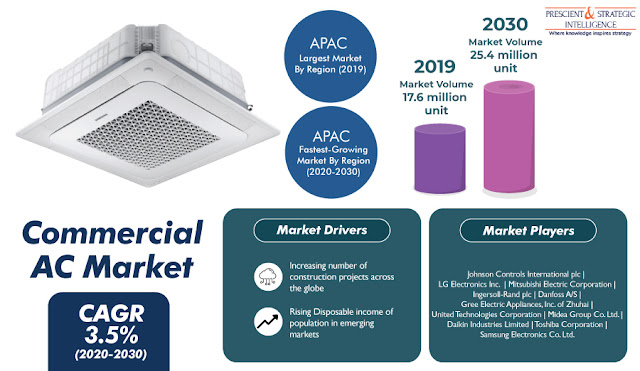At present, players of the commercial AC market, such as Johnson Controls International PLC, Mitsubishi Electric Corporation, Danfoss A/S, Samsung Electronics Co. Ltd., Midea Group Co. Ltd., United Technologies Corporation, and Toshiba Corporation, are focusing on introducing new cooling equipment to gain a competitive edge. For instance, in September 2019, Mitsubishi Electric Corporation launched a VRF system containing the R32 refrigerant in the U.K. to meet the burgeoning demand for environment-friendly electrical appliances.
Similarly, in January 2020, LG Electronics Inc. introduced the Whisen ThinQ line of ACs in Seoul, South Korea. Categories under the type segment of the commercial AC market are variable refrigerant flow (VRF), ducted split/packaged unit, split units, chillers, and room ACs. In 2019, the split units category held the largest market share, as they can be used independently for effective and appropriate cooling.
As compared to other AC types, these units are easy to maintain and operate. Whereas, the VRF category is expected to display the fastest growth during the forecast period, due to the high cost-effectiveness and energy efficiency offered by VRF systems. Geographically, Asia-Pacific (APAC) accounted for the largest share in the commercial AC market during the historical period (2014–2019), and it is also expected to demonstrate the fastest growth during the forecast period.
This can be attributed to the growth of the construction sector in the region. Moreover, the booming population, especially in India and China, and mounting disposable income of people will also contribute to the market growth in the in the region in the foreseeable future. Thus, the flourishing construction industry, especially in developing countries, will steer the market growth in the forthcoming years.
This market research report provides a comprehensive overview of the market
Similarly, in January 2020, LG Electronics Inc. introduced the Whisen ThinQ line of ACs in Seoul, South Korea. Categories under the type segment of the commercial AC market are variable refrigerant flow (VRF), ducted split/packaged unit, split units, chillers, and room ACs. In 2019, the split units category held the largest market share, as they can be used independently for effective and appropriate cooling.
Get the Sample Copy of this Report @ https://www.psmarketresearch.com/market-analysis/commercial-ac-market/report-sample
As compared to other AC types, these units are easy to maintain and operate. Whereas, the VRF category is expected to display the fastest growth during the forecast period, due to the high cost-effectiveness and energy efficiency offered by VRF systems. Geographically, Asia-Pacific (APAC) accounted for the largest share in the commercial AC market during the historical period (2014–2019), and it is also expected to demonstrate the fastest growth during the forecast period.
This can be attributed to the growth of the construction sector in the region. Moreover, the booming population, especially in India and China, and mounting disposable income of people will also contribute to the market growth in the in the region in the foreseeable future. Thus, the flourishing construction industry, especially in developing countries, will steer the market growth in the forthcoming years.
This market research report provides a comprehensive overview of the market
- Future potential of the market through its forecast for the period 2020– 2030
- Major factors driving the market and their impact during the short, medium, and long terms
- Market restraints and their impact during the short, medium, and long terms
- Recent trends and evolving opportunities for the market participants
- Historical and the present size of the market segments and understand their comparative future potential
- Potential of on-demand logistics services, so the market players make informed decisions on the sales of their offerings

Comments
Post a Comment